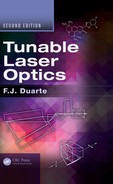9
Lasers and Their Emission Characteristics
9.1 Introduction
The aim of this chapter is to provide an utilitarian and succinct overview of the emission characteristics of lasers. Lasers included in this survey emit mostly in the ultraviolet–visible–near-infrared part of the spectrum and offer one, or more, of the following features:
Narrow linewidth emission
TEM00 beam profile
High pulsed powers, high average powers, or high continuous-wave (CW) powers
At this stage, it should be indicated that lasers that exhibit naturally a high degree of spectral coherence tend to be lasers that derive their emission from discrete atomic transitions. Examples of such coherent sources are found among the CW gas lasers, which also tend to emit laser beams with TEM00 characteristics. High-gain, high-power, lasers can be configured to yield both TEM00 beam characteristics and narrow-linewidth emission using a variety of optical architectures, as described in Chapter 7.
As discussed in a previous publication (Duarte 1995a), different types of lasers cover different spectral regions and offer different optimized modes of operation and emission. As such, different lasers should be considered from a perspective of complementarity. In this context, it is the application itself that should determine the selection of a particular laser. Among the characteristics that determine the suitability of a particular, pulsed or CW, laser for a given application are
Spectral region of emission
Wavelength tunability
Laser linewidth
Amplified spontaneous emission (ASE) level
Wavelength and linewidth stability
Beam profile
Pulse duration
Pulse energy
Average power
CW power
Physical and optical ruggedness
Physical dimensions
Cost and environment
An example of complementarity in the laser field can be provided considering the application of laser isotope separation. Here, the spectroscopic information can be obtained using either CW dye lasers or tunable external cavity diode lasers (see, e.g., Olivares et al. 2002). However, large-scale isotope separation requires high-power narrow-linewidth dye lasers efficiently excited by copper vapor lasers (CVLs) operating in the high-pulse repetition frequency (prf) regime (Broyer et al. 1984; Bass et al. 1992; Singh et al. 1994; Sugiyama et al. 1996). A further example of complementarity is provided by recent applications in laser cooling where the lasers of choice are external cavity tunable semiconductor lasers, with CW dye lasers being employed to provide highly coherent radiation in spectral regions unattainable with the compact diode lasers (Bradley et al. 2000).
For the purpose of this survey, high-power pulsed lasers are those lasers belonging to a class capable of generating pulsed powers starting in the tens of kilowatts regime. High-energy lasers are those lasers capable of generating at least tens of joules per pulse. Lasers classified as high average, or high CW, powers are those lasers capable of delivering powers starting at the several tens of watts level.
It should be noted that this survey should not be considered a historical introduction to the subject of lasers since references were mainly selected for the instructional value of their data. Furthermore, information about high-power gas lasers and high-power liquid lasers is included for three reasons: (1) the energy and power performance of some of these lasers has not yet been superseded by the output characteristics of recent semiconductor, or semiconductor-excited solid-state, laser alternatives; (2) it is important to emphasize the vast variety of laser materials from the gaseous to the solid state; and (3) technology can always surprise us with the revival of previous accomplishments.
9.2 Gas Lasers
The emission of high pulse energies, or high average powers, requires the rapid removal of heat. Gas lasers are ideally suited for the efficient removal of excess heat. In this section, representative gas lasers from the subclasses of molecular and atomic transitions are included.
9.2.1 Pulsed Molecular Gas Lasers
Among the most widely used high-power gas lasers are those that derive their radiation from molecular transitions. Table 9.1 includes these lasers and relevant emission characteristics. Excimer lasers can be excited either via e-beam technology or, more commonly, using electrical discharges. An excimer molecule, such as XeCl, does not readily exist in nature and is created by the interaction of energetic electrons with a gas mixture that includes a buffer gas that participates in the excitation process, such as He, and the components of the lasing molecules such as Xe and Cl.
TABLE 9.1
Molecular Ultraviolet and Visible Pulsed Gas Lasers
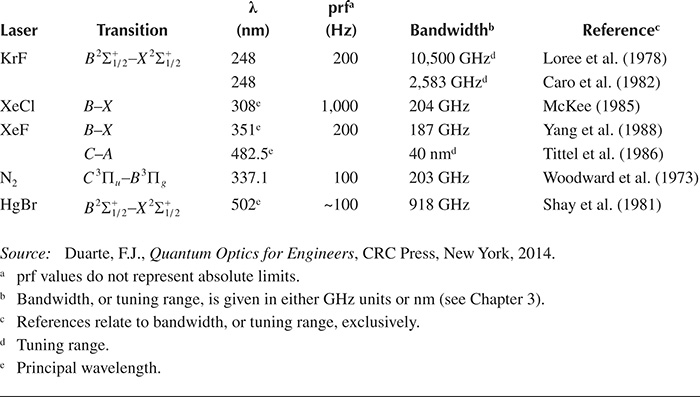
Discharge-excited excimer lasers are available in a variety of designs that provide an ample choice of performance parameters from joule-class pulse energies, at low repetition rates, to millijoule-type lasers operating at a prf of hundreds of hertz and approaching the kilohertz regime. Commercial excimer lasers offer average powers from a few watts to hundreds of watts. Pulse duration in excimer lasers is a function of the discharge configuration and the type of excimer. Most excimer lasers provide pulses in the 20–30 ns range; however, using inductance stabilized circuits, pulses as long as 180 ns in KrF and 250 ns in XeCl have been reported (Sze and Harris 1995). Excimer lasers tend to yield wide beams with multiple–transverse-mode structures. Adoption of unstable resonator techniques can be used to improve the beam quality and linewidth performance can be improved significantly using, for example, intracavity multiple-prism grating techniques (Ludewigt et al. 1987; Duarte 1991a). For a comprehensive review on excimer lasers, the reader should refer to Rhodes (1979). Sze and Harris (1995) provide an excellent discussion of tunable excimer lasers.
Nitrogen lasers are reliable, simple to build, and easy to operate. The N2 laser emits via two electronic transitions: one is the C3Πu − B3Πg transition, in the ultra-violet, and the other is the ![]() transition, in the near infrared. In the ultraviolet system, three vibrational transitions, corresponding to v′ = 0 →v′′ = 0, v′ = 0 →v′′ = 1, and v′ = 1 →v′′ = 0, are observed at 337.1, 357.7, and 315.9 nm, respectively (Willett 1974). Of these transitions, the one at 337.1 nm has the largest Franck–Condon factor. N2 lasers emitting at this wavelength often deliver energies of about 10 mJ in the pulsed regime, which is approximately 10 ns wide (full width at half maximum [FWHM]) at prfs from a few hertz up to 100 Hz.
transition, in the near infrared. In the ultraviolet system, three vibrational transitions, corresponding to v′ = 0 →v′′ = 0, v′ = 0 →v′′ = 1, and v′ = 1 →v′′ = 0, are observed at 337.1, 357.7, and 315.9 nm, respectively (Willett 1974). Of these transitions, the one at 337.1 nm has the largest Franck–Condon factor. N2 lasers emitting at this wavelength often deliver energies of about 10 mJ in the pulsed regime, which is approximately 10 ns wide (full width at half maximum [FWHM]) at prfs from a few hertz up to 100 Hz.
CO2 lasers emit in the infrared mainly in the 10 μm region. These lasers can be configured into powerful sources of coherent emission in both the pulsed and the CW regime. Information about the transitions of CO2 lasers was provided by Willett (1974). In the case of pulsed TEA CO2 lasers, emission occurs via the P20 (00°1 - 10°0) transition corresponding to λ = 10,590 nm and their emission bandwidth prior to narrowing can be in the 3–4 GHz range (Duarte 1985a, 1985b, 1985c).
Since molecular transitions give origin to emission bands, these lasers are tunable. Application of the line-narrowing techniques described in Chapter 7 can yield tunable narrow-linewidth emission. Narrow-linewidth tunable pulsed excimer lasers are summarized in Table 9.2 and narrow-linewidth tunable pulsed CO2 lasers in Table 9.3.
TABLE 9.2
Narrow-Linewidth Tunable Pulsed Excimer Laser Oscillators

TABLE 9.3
Narrow-Linewidth Tunable Pulsed CO2 Laser Oscillators
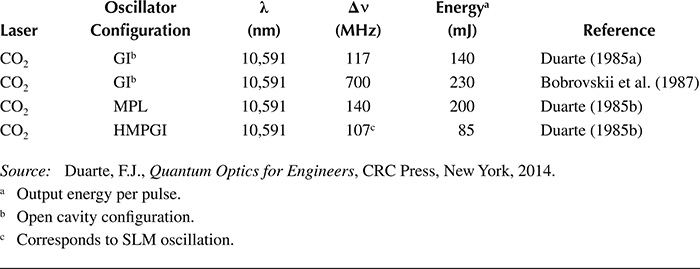
9.2.2 Pulsed Atomic Metal Vapor Lasers
Emission characteristics of atomic pulsed metal vapor lasers are given in Table 9.4. Perhaps, the most well-known member of this subgroup is the copper laser, which is also referred to as the copper vapor laser. These lasers have found numerous applications due to their ability to emit large average powers in the green at λ = 510.554 nm and, at their secondary emission wavelength, at λ = 578.21 nm. CVLs use a buffer gas, such as He or Ne, and operate at a high prf in order to attain the necessary metal vapor pressure. Excitation of the upper 2 P state occurs mainly via direct electron excitation (Harstad 1983). Output parameters from individual Cu lasers have been reported to cover a wide range of values. At pulsed energies of up to several millijoules per pulse, these lasers can emit pulses in the 10–60 ns range, at prfs from 2 to 32 kHz (Webb 1991). For instance, a specific CVL can yield an average power of 100 W, at 20 mJ per pulse, and a prf of 5 kHz (Webb 1991). Integrated CVL systems have been reported to yield average powers of up to 7 kW at a prf of 26 kHz (Bass et al. 1992). Copper lasers can also be operated at low repetition rates using copper halides to attain the necessary vapor pressures at relatively low temperatures (Piper 1978; Brandt and Piper 1981).
CVLs have been reported in a variety of cavity arrangements including plane mirror resonators and various unstable resonator configurations (Webb 1991). These lasers are useful for a number of applications, including the excitation of tunable dye lasers at low and high prfs (Duarte and Piper 1982, 1984; Webb 1991).
9.2.3 CW Gas Lasers
TABLE 9.4
Atomic Pulsed Gas Lasers

Perhaps the most well-known gas laser is the helium–neon (He–Ne) laser. Its most well-known line corresponds to the 3s2 − 2p4 transition at λ = 632.82 nm. This transition is made possible by excitation transfer from atoms at the helium metastable level He* (23 S1) to ground-state Ne atoms (Willett 1974). The emission from this laser is characterized by a most beautiful TEM00 beam at a laser linewidth typically less than a few gigahertz in the absence of frequency-selective intracavity optics. At the referred wavelength, and depending on the discharge length, available powers vary from a few milliwatts to a few tens of milliwatts. Additional transitions available from the He–Ne laser are listed in Table 9.5. He–Ne lasers incorporating broadband mirrors and tuning optics can emit at several visible transitions.
TABLE 9.5
Transitions of CW He–Ne Laser
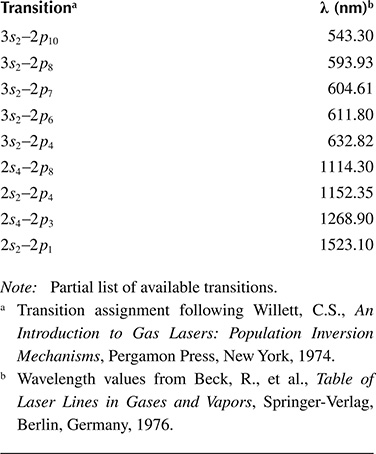
Another CW gas laser that is widely used in the laboratory, due to its powerful blue-green transitions, is the Ar+ laser. All the transitions listed in Table 9.6 are excited via electron impact (Willett 1974). The dominant CW transitions are those at 487.99 and 514.53 nm. It should be noted that relatively compact Ar+ lasers can be engineered to deliver powers at the tens of milliwatts range, whereas large systems have been configured to yield as much as 175 W (Anliker et al. 1977). An additional feature of laboratory Ar+ lasers is the option to tune from line to line using intracavity optics.
Additional CW metal vapor lasers are the He–Zn and He–Cd lasers. Ion transitions in these lasers are excited via Penning and Duffendack reactions (Piper and Gill 1975). In the first reaction, the helium metastable He* (3S1) interacts with the metal atoms, whereas in the second reaction, it is helium ion He+ (2S1/2) that participates in the excitation. In the case of the He–Zn laser, the transitions at 491.16, 492.40, and 758.85 nm are excited via Duffendack reactions, which can only occur in hollow-cathode discharges that give origin to energetic electrons. Using a hollow-cathode He–CdI2 discharge, Piper (1976) combined simultaneously 4 transitions from Cd+ and 11 transitions from I+ to produce a most striking TEM00 white light laser beam. All of the I+ transitions listed in Table 9.5 participated in the emission plus the Cd+ transitions at 441.56, 533.75, 537.80, and 806.70 nm. All of these transitions are excited via Duffendack reactions except the 441.56 nm transition from Cd+ that results from Penning ionization.

TABLE 9.6
Ionized CW Gas Lasers
For a survey of CW CO2 lasers, the reader should refer to Willett (1974) and Freed (1995). An excellent review on frequency selectivity in CO2 lasers was provided by Tratt et al. (1985).
9.3 Organic Dye Lasers
Dye lasers are inherently tunable and intrinsically apt for the generation of high average powers (Duarte 1991b). These lasers can be divided into two main categories: pulsed dye lasers and CW dye lasers. These lasers, using various dyes, can span the electromagnetic spectrum from the near ultraviolet to the near infrared (see Chapter 1). Some individual dyes, such as rhodamine 6G, can provide tuning ranges in excess of 50 nm, centered at λ ≈ 590 nm, whereas coumarin 545T has been shown to be tunable in the 501 ≤ λ ≤ 574 nm range (Duarte et al. 2006). For historical reviews, the reader should refer to Schäfer (1990) or Duarte and Hillman (1990).
9.3.1 Pulsed Organic Dye Lasers
Pulsed dye lasers are divided into two subclasses: laser-pumped pulsed dye lasers and flashlamp-pumped pulsed dye lasers.
As apparent from Table 9.7, laser-pumped dye lasers can provide either hundreds of joules per pulse at low repetition rates or very high average powers, well into the kilowatt regime at prfs in excess of 10 kHz. Excellent reviews on CVL-pumped dye lasers are given by Webb (1991) and on excimer laser-pumped dye lasers by Tallman and Tennant (1991).
The performance of laboratory-size laser-pumped dye lasers can be illustrated, considering the work of Bos (1981) who reported a linewidth of Δν ≈ 320 MHz at λ = 590 nm with a telescopic oscillator incorporating an intracavity etalon. Using three stages of amplification, the output energy was 165 mJ at an overall conversion efficiency of 55% for excitation at 532 nm. Employing a HMPGI grating oscillator and two stages of amplification, Dupre (1987) reported 3.5 mJ, and Δν = 1.2 GHz, at λ = 440 nm. The conversion energy efficiency waŝ9% for excitation at 355 nm.
TABLE 9.7
High-Power Laser-Pumped Organic Dye Lasers
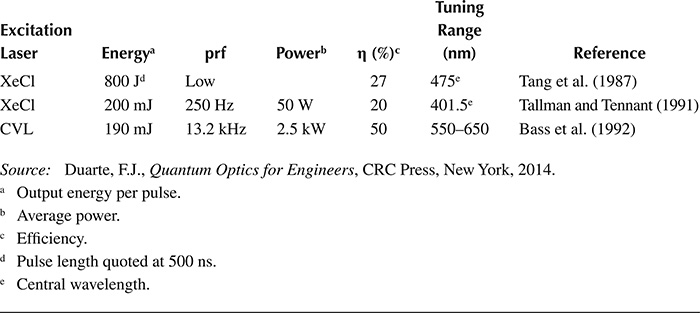
CVL excitation of HMPGI grating oscillators yielded Δν ≈ 600 MHz, for λ = 575 nm, and a pulse length of 12 ns (FWHM) at a conversion efficiency of ~5% (Duarte and Piper 1984). The average output power was 80 mW at a prf of 8 kHz. Using the same class of multiple-prism oscillator, and one amplifier stage, Singh et al. (1994) reported Δν ≈ 1.5 GHz and a conversion efficiency of 40% at a prf of 6.5 kHz. Emission characteristics of narrow-linewidth tunable dye laser oscillators are summarized in Table 9.8.
The performance of large flashlamp-pumped dye lasers is summarized in Table 9.9. For a comprehensive and authoritative review of flashlamp-pumped dye lasers, the reader should consult Everett (1991). In general, these lasers have been used to generate large energies in pulses up to the microsecond regime. The energy per pulse is so high that fairly modest prfs can generate average powers in the kilowatt regime. In this regard, organic dye lasers continue to provide the best alternative for high-energy pulse generation tunable directly in the visible spectrum (Duarte 2012), which is an attractive avenue for directed energy applications.
Besides their intrinsic ability to generate large pulsed energies, flashlamp-pumped dye lasers have also been configured in small-scale laboratory versions designed to yield narrow-linewidth, highly stable, tunable laser emission. For a review on this subject, see Duarte (1995b).
A ruggedized MPL grating coaxial flashlamp-pumped dye laser oscillator yielding a single-transverse-mode laser beam with Δθ ≈ 0.5 mrad, and a laser linewidth of Δν ≈ 300 MHz, at λ ≈ 590 nm, was reported by Duarte et al. (1991). The emission was extremely pure with ASE levels a few parts in 10−7. This dispersive oscillator provided ~3 mJ per pulse, at a pulse length of Δt ≈ 50 ns, using rhodamine 590 at a concentration of 0.01 mM. Its wavelength stability was measured to be (δλ/λ) ≈ 5 × 10-7. This organic tunable laser was engineered in an all-Invar structure and its gain medium was flowed in a hermetically sealed stainless steel and polytetrafluoroethylene system. This ruggedized oscillator (also included in Table 9.8) was shown to maintain its wavelength and linewidth characteristics following displacement on a rugged terrain (Duarte et al. 1991).
TABLE 9.8
Narrow Linewidth Liquid Organic Dye Lasers

TABLE 9.9
High-Energy Flashlamp-Pumped Organic Dye Lasers
Excitation |
Δt (μs) |
Energy (J) |
η (%) |
Reference |
7 |
40 |
0.4 |
Fort and Moulin (1987) |
|
5 |
140d |
1.8 |
Klimek et al. (1992) |
|
Coaxialb |
10 |
400 |
0.8 |
Baltakov et al. (1974) |
Source: Duarte, F.J., Quantum Optics for Engineers, CRC Press, New York, 2014.
a Employs 12 flashlamps in a linear configuration.
b Uses rhodamine 6G dye.
c Employs 16 flashlamps in a transverse configuration.
d Yields an average power of 1.4 kW at a prf of 10 Hz.
The output from narrow-linewidth oscillators can be amplified using single-stage amplifiers to yield hundreds of millijoules per pulse. Flamant and Maillard (1984) used a two-etalon oscillator to excite a flat-mirror amplifier to attain Δν = 346 MHz and a pulse energy of 300 mJ at λ = 590 nm. Using a multiple-prism grating oscillator and a single-stage unstable-resonator amplifier, Duarte and Conrad (1987) achieved Δν = 375 MHz and a pulse energy of 600 mJ at λ = 590 nm.
9.3.1.1 Solid-State Tunable Organic Lasers
In addition to traditional liquid organic dye lasers, there has been considerable research and development activity in the area of solid-state dye lasers. Excellent reviews on dye-doped solid-state matrices was provided by Costela et al. (2009, 2013) and the photophysical properties of organic dye-doped polymer gain materials were characterized by Holzer et al. (2000). Dye-doped polymer-nanoparticle gain media was demonstrated to lase efficiently while exhibiting TEM00 and reduced beam divergence by Duarte and James (2003). The performance of broadband solid-state organic dye lasers is summarized in Table 9.10.
Although most of the recent activity has been centered around polymeric matrices, and hybrid silicate–polymer composite materials, there has also been work reported on crystalline dye lasers (Rifani et al. 1995; Braun et al. 2000). Reviews of organic lasers, mainly centered around optically pumped conjugate polymers, are given by Karnutsch (2007) and Samuel et al. (2007).
TABLE 9.10
Broadband Solid-State Organic Dye Lasers
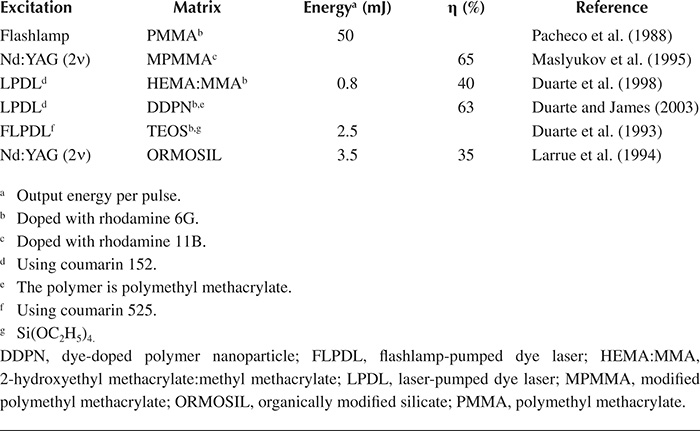
Optimized high-performance multiple-prism grating solid-state organic oscillators, as described in Chapter 7, have yielded tuning in the 550 ≤ λ ≤ 603 nm range with TEM00 laser beams with beam divergences ~1.5 times the diffraction limit. The emission is in a single longitudinal mode (SLM) at Δν ≈ 350 MHz in pulses Δt ≈ 3 ns (FWHM) with a near-Gaussian temporal profile. Conversion efficiency is reported at ~5% and the ASE levels are extremely low at ~10−6 (Duarte 1999).
TABLE 9.11
Narrow-Linewidth Solid-State Organic Laser Oscillators
Cavity |
Matrix |
Δ ν |
Λt |
Tuning (nm) |
Energya (mJ) |
MPMMAd |
350 MHze |
3 ns |
550 ≥ λ ≥ 603 |
~0.1f |
|
HEMA:MMAi |
650 MHz |
105 ns |
564 ≤ λ ≤ 602 |
~0.4 |
Source: Duarte, F.J., Quantum Optics for Engineers, CRC Press, New York, 2014.
aOutput energy per pulse.
bLaser-pumped dye laser; optimized cavity.
cData from Duarte, F.J., Appl. Opt., 38, 6347–6349, 1999.
dDoped with rhodamine 6 G.
eLinewidth corresponds to SLM oscillation.
fPower per pulsê33 kW.
gFlashlamp-pumped dye laser.
hData from Duarte, F.J., et al., Appl. Opt., 37, 3987–3989, 1998.
iHEMA:MMA doped with rhodamine 6 G.
HEMA:MMA, 2-hydroxyethyl methacrylate:methyl methacrylate; MPLG, multiple-prism Littrow grating configuration; MPMMA, modified polymethyl methacrylate.
Transverse excitation in the long-pulse regime of a four-prism grating solid-state dye laser oscillator has led to pulses a long as Δt ≈ 105 ns (FWHM), and Δν ≈ 650 MHz, in the 564 ≤ λ ≤ 602 nm tuning range. The pulse energies are reported to be ~0.4 mJ per pulse (Duarte et al. 1998). The characteristics of these high-performance solid-state organic laser oscillators are summarized in Table 9.11.
9.3.2 CW Organic Dye Lasers
Dye lasers have had a significant impact in high resolution spectroscopy, and other iconic applications including laser cooling, given their tunability, excellent TEM00 beam quality, and intrinsic narrow linewidths that can readily reach the few megahertz level. CW dye lasers typically use Ar + and Kr + as excitation sources, although in principle they could use any compatible laser yielding TEM00 emission. It should be noted that CW dye lasers have been excited with a variety of lasers including diode lasers (see, e.g., Scheps 1993). Table 9.12 summarizes the performance of relatively high-power CW dye lasers, some of which yield SLM oscillation at linewidths in the megahertz regime. Stabilization techniques resulting in the demonstration of laser linewidths as low as 100 Hz (Drever et al. 1983) are discussed in an excellent review by Hollberg (1990).
A further towering contribution of the CW dye lasers to the field of optics and lasers was their use as principal tools in the development of ultrashort pulse lasers that gave origin to the femtosecond lasers. Among the important concepts developed in this endeavor were the generation of bandwidth-limited ultrashort pulses (Ruddock and Bradley 1976), the colliding-pulse mode locking technique (Fork et al. 1981), and prismatic pulse compression (Dietel et al. 1983; Fork et al. 1984) (see Chapter 4). Using an extracavity pulse compressor, consisting of a four-grating array and a four-prism array, Fork et al. (1987) compressed a 50 fs pulse further to just 6 fs. Diels (1990) and Diels and Rudolph (2006) provided comprehensive reviews on this subject. Table 9.13 summarizes the performance of femtosecond pulse organic lasers.
TABLE 9.12
Performance of High-Power CW Organic Dye Lasers
Cavity |
Spectral Range (nm) |
Δν |
Powera |
η (%) |
Reference |
Linearb |
30 |
Anliker et al. (1977) |
|||
Linearb |
560-650 |
SLMe |
17 |
Baving et al. (1982) |
|
Ringb |
407-887h |
SLMe |
5.6 Wi |
23.3 |
Johnston and Duarte (2002) |
aCW output power.
bUnder Ar+ laser excitation.
cMaximum CW power quoted: 52 W for a pump power of 175 W.
dUsing rhodamine 6G at 0.7 mM.
eLinewidth values can be in the few MHz range.
fWithout intracavity tuning prism, the quoted output power is 43 W for a pump power of 200 W.
gUsing rhodamine 6G at 0.94 mM.
hUsing 11 dyes.
iUsing rhodamine 6G.
TABLE 9.13
Femtosecond Pulse Dye Lasers
Pulse Compressor |
Δt (fs) |
Reference |
Single prism |
60 |
Dietel et al. (1983) |
Double prism |
50 |
Kafka and Baer (1987) |
Double prism |
18 |
Osvay et al. (2005) |
Four prisms |
29 |
Kubota et al. (1988) |
Four prisms plus grating pair |
6 |
Fork et al. (1987) |
9.4 Solid-State Lasers
The solid-state laser field is a vast field that includes traditional crystalline materials and fiber gain media. These lasers can emit in both the pulse and CW regimes. In this section, some of the most well-known gain media are surveyed with emphasis on spectral characteristics.
9.4.1 Ionic Solid-State Lasers
Optically pumped ionic solid-state lasers include the well-known Nd laser that can exist either in a crystalline or in a glass host. These lasers are very well suited to be configured in various cavity arrangements, including unstable resonator arrangements, which yield single-transverse-mode emission. The linewidth of a TEM00 laser at 1064 nm is typically 15–30 GHz (Chesler and Geusic 1972). Frequency doubling using nonlinear crystals, intracavity or extracavity, yields efficient conversion into the visible. Originally, these lasers were excited using flashlamp pumping; however, diode laser pumping has become rather pervasive. Commercially available diode laser-pumped Nd:YAG lasers can yield tens of watts at prfs in the kilohertz regime. Individual laser pulse lengths can be in the 10–15 ns range. Ionic gain media, in crystalline hosts, has also lased in the CW regime.
Nd:glass lasers are mainly operated at very high peak powers, and low prfs, in the TW regime. Some of the most well-known ionic solid-state lasers, with their respective transitions, are listed in Table 9.14.
9.4.2 Transition Metal Solid-State Lasers
Transition metal solid-state lasers include the alexandrite and Ti:sapphire lasers that are widely tunable. This quality has made the Ti:sapphire lasers particularly applicable to the generation of ultrashort pulses in the femtosecond regime. Although the ruby laser is mainly operated in the pulsed regime, typically delivering a few joules of energy per pulse, the other two media are very versatile and are well suited to both pulsed and CW operations (Walling and Peterson 1980; Walling et al. 1980a; Moulton 1986). Tuning ranges are listed in Table 9.15. A comprehensive review of transition metal solid-state lasers was given by Barnes (1995a).
All-solid-state Ti:sapphire lasers are available commercially with TEM00 beam profiles, and emission in the SLM domain, delivering average powers in the watt regime at ~10 kHz. Using CVL pumping, narrow-linewidth emission has been demonstrated at average powers of 5 W at 6.2 kHz, at a conversion efficiency of ~26% (Coutts et al. 1998). Liquid nitrogen cooling of Ti:sapphire gain media has resulted in CW output powers of up to 43 W at an efficiency of ~42% for broadband lasing (Erbert et al. 1991). In the ultrashort pulse regime, Ti:sapphire lasers have been shown to deliver pulses as short as 5 fs (Ell et al. 2001).
TABLE 9.14
Ionic Solid-State Lasers
Ion |
Transition |
λ (nm) |
Yb3+ |
2-F5/2−2-F7/2 |
1015 |
Nd3+ |
4-F3/2−2-I11/2 |
1064 |
Er3+ |
4-F13/2−2-F15/2 |
1540 |
Tm3+ |
3-H4−3-H6 |
2013 |
Ho3+ |
5-I7−5-I8 |
2097 |
TABLE 9.15
Transition Metal Solid-State Lasers
Ion:Host Crystal |
Transition |
λ (nm) |
Reference |
Cr3+:Al2O3 |
2E(Ē)-4A2 |
694.3 |
Maiman (1960) |
Cr3+:Be3Al2(SiO3)6 |
4T2−4A2 |
695 ≤ λ ? 835 |
Shand and Walling (1982) |
Cr3+:BeAl2O4 |
4T2−4A2 |
701 ≤ λ ≤ 818 |
Walling et al. (1980b) |
Ti3+:Al2O3 |
2T2−2E |
660 ≤ λ ≤ 986 |
Moulton (1986) |
TABLE 9.16
Ultrashort Pulse Solid-State Lasers
Laser |
Post Laser |
Δt (fs) |
λ (nm) |
Energy |
Reference |
Ti3+:Al2O3 |
Noncollinear OPAa |
6.9 |
20 μJ |
Tavella et al. (2010) |
|
Ti3+:Al2O3 |
Chirped mirror compressor |
3.64b |
810c |
Demmler et al. (2011) |
aOptics includes a two-prism stretcher, a fiber stretcher, and two fiber preamplifiers.
b1.3 cycle at 810 nm.
cCentral wavelength.
Titanium sapphire lasers emitting in the ultrafast, or ultrashort pulse, regime are included in Table 9.16.
9.4.3 Color Center Lasers
Laser-excited color center lasers span the electromagnetic spectrum mainly in the near infrared at the 0.82 ≤ λ ≤ 3.3 μm region. Lasing has been reported mainly in the CW regime at power levels in the 10 mW–2.7 W range. An excellent review article on this subject was written by Mollenauer (1985).
Using the center F2 in a LiF host, lasing in the 0.82–1.05 μm region was reported with a maximum power of 1.8 W (Mollenauer and Bloom 1979). Using the same center in a KF host, the same authors reported laser emission in the 1.22 ≤ λ ≤ 1.50 μm region at a maximum power of 2.7 W for an excitation power of ~5 W. Narrow-linewidth emission was reported by German (1981), using the FA(II) center in a RbCl:Li host, in a grazing-incidence cavity configuration. SLM oscillation was reported at power levels in excess of 10 mW in the 2.7 ≤ λ ≤ 3.1 μm region.
9.4.4 Diode Laser-Pumped Fiber Lasers
An area of the solid-state laser field that has evolved rapidly over the past few years is the fiber laser subfield. Glass or silica fibers doped with elements such as Yb, Nd, Er, or Tm are the active media that are increasingly excited with high-power diode lasers. From the versatility of doping elements, it should be apparent that these lasers cover the near infrared from beyond 1 μm to about 3 μm. Since the breadth and scope of this subfield is enormous, attention is only given to some of the important characteristics of fiber lasers. First, these lasers can be extremely efficient. Second, as indicated in Table 9.17, they can achieve high output CW powers under diode laser excitation. The third important quality of diode laser-pumped fiber lasers is broad continuous tunability. These qualities are well illustrated by fiber lasers included in Table 9.18.
TABLE 9.17
Diode Laser-Pumped Yb-Doped Fiber Lasers

TABLE 9.18
Tunable Fiber Lasers
Tuning Technique |
Tuning (nm) |
Δν |
CW Power |
Reference |
HTGIGa |
1032 ≤ λ ≤ 1124 |
2.5 GHz |
10 Wb |
Auerbach et al. (2002) |
BGc (Er3+) |
1510 ≤ λ ≤ 1580 |
100 MHz |
0.5 mW |
Chen et al. (2003) |
GIG (Tm3+) |
2275 ≤ λ ≤ 2415 |
210 MHz |
6.0 mW |
McAleavey et al. (1997) |
aHybrid telescope grazing-incidence grating configuration in a ring cavity.
bExcitation wavelength at 980 nm.
BG, Bragg grating; GIG, grazing-incidence grating.
In regard to the narrow-linewidth tunable laser reported by Auerbach et al. (2002), it should be mentioned that the authors reported extremely low levels of ASE. Also, the hybrid telescope grazing-incidence (HTGI) grating configuration (Yodh et al. 1984; Smith and DiMauro 1987) used to induce narrow-linewidth oscillation is a variant of the principle of the HMPGI grating configurations (Duarte and Piper 1981, 1984) that is described in Chapter 7. Tunable fiber lasers were reviewed in detail by Shay and Duarte (2009).
9.4.5 Optical Parametric Oscillators
Although the optical parametric oscillator (OPO) does not involve the process of population inversion in its excitation mechanism, it is included, nevertheless, since it is a source of spatially, and spectrally, coherent emission which is inherently tunable. For detailed review articles on this subject, the reader is referred to Barnes (1995b) and Orr et al. (1995, 2009). The nonlinear optics aspects of OPOs are examined in Chapter 8. Spectral characteristics of several well-known OPOs are given in Table 9.19.
TABLE 9.19
Pulsed OPOs
Crystal |
Optical Transmissiona |
λp (nm) |
Tuning (μm) |
Reference |
KTP |
0.35-4.5 |
532 |
0.61 ≤ λ ≤ 4.0 |
Orr et al. (1995) |
BBO |
0.20-2.2 |
355 |
0.41 ≤ λ ≤ 3.0 |
Orr et al. (1995) |
LBO |
0.16-2.3 |
355 |
0.41 ≤ λ ≤ 2.47 |
Schröder et al. (1994) |
LiNbO3 |
0.33-5.5 |
532 |
0.61 ≤ λ ≤ 4.4 |
Orr et al. (1995) |
AgGaS2 |
0.15-13 |
1064 |
1.4 ≤ λ ≤ 4.0 |
Fan et al. (1984) |
aFor the ordinary ray. (Data from Barnes, N.P., Tunable Lasers Handbook, Academic Press, New York, 1995a.)
OPOs are optically pumped devices that make wide use of Nd:YAG lasers and the different harmonics that can be provided with these excitation sources. A fairly instructive case study on the performance of pulsed OPOs was provided by Schröder et al. (1994) who reported an output energy of 77 mJ for an excitation energy of 170 mJ, at 355 nm, for a 15 mm-long LiB3O5 crystal. The emission bandwidth was ~0.5 nm (~366 GHz) at λ ≈ 640 nm. This performance was obtained using excitation pulses 5–6 ns in duration at a prf of 10 Hz. Pulsed OPOs for analytical applications tend to operate at prfs of ~10 Hz (He and Orr 2001). Barnes and Williams-Byrd (1995) discuss thermally induced phase mismatch and thermally induced lensing that tend to limit the average power in OPOs and optical parametric amplifiers.
Certainly, all the linewidth narrowing techniques described in Chapter 7 are applicable to OPOs and further details are given in Chapter 8. For example, a multiple-prism grating cavity, incorporating an intracavity etalon, in a LiNbO3 OPO yielded a linewidth of Δν ≈ 30 MHz at λ ≈ 3.4 μm. The energy conversion efficiency was reported at ~0.74%.
Initially, OPOs in the CW regime were longitudinally excited by CW frequency-doubled Nd:YAG lasers (Smith et al. 1968). An improved approach consists in using diode laser excitation in intracavity configurations. Using fiber-coupled excitation from a diode laser, at 940 nm, Jensen et al. (2002) excited a Yb:YAG crystal whose emission was focused on a periodically poled LiNbO3 crystal. For a diode laser power of 13.5 W, tunable emission in the 3.82 ≤ λ ≤ 4.57 μm range was reported at output powers of 200 mW (Jensen et al. 2002).
Femtosecond OPOs in linear and ring cavities, incorporating multiple-prism pulse compressors, were discussed by Powers et al. (1993). An authoritative and detailed review on the performance and output characteristics of OPOs for spectroscopic applications was given by Orr et al. (2009).
9.5 Semiconductor Lasers
The area of semiconductor lasers is a rapidly evolving field that can be classified into high-power diode lasers, external cavity lasers, and miniature lasers. Semiconductor lasers work via direct electrical excitation, are compact, offer wavelength tunability, and can be very stable. The approximate tuning ranges available from various semiconductor laser materials are listed in Table 9.20. Their compactness, with aperture dimensions in the micrometer regime, results in large beam divergences that require external, or intracavity, beam shaping optics to reduce the divergence (see Chapter 7).
High-power diode lasers, as those used in the excitation of crystalline solid-state lasers and fiber lasers, integrate many individual diode lasers to increase the overall output power. Arrays of numerous diode lasers in parallel form what is known as a bar. The divergent emission from these bars is collected and guided using external beam shaping optics. As indicated in Table 9.21, these bars can yield powers in the 10–40 W range. For uses requiring even higher output powers, such as industrial applications, the bars are further integrated into stacks. These stacks can yield powers in the kilowatt regime.
TABLE 9.20
Wavelength Coverage of Semiconductor Laser Materials
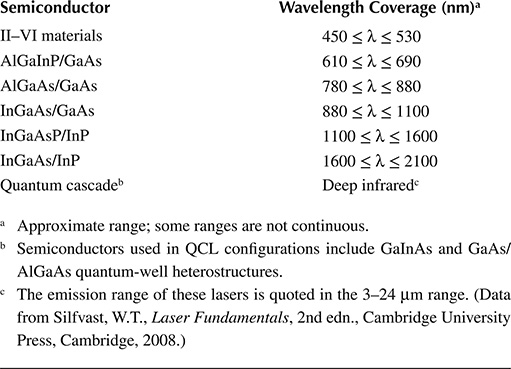
TABLE 9.21
CW Diode Laser Arrays
λ (nm) |
CW Output Power |
Reference |
791 |
10 W |
Srinivasan et al. (1999) |
~915 |
45 W |
Dominic et al. (1999) |
975 |
1.2 kW |
Jeong et al. (2004) |
One area of research that has received considerable attention is the line narrowing and tunability of semiconductor devices. External cavity tunable semiconductor lasers utilize grating and multiple-prism grating cavity architectures similar to those described in Chapter 7. The performance of these lasers, which have been widely applied in areas such as laser cooling, and Bose–Einstein condensation, is summarized in Table 9.22. Note that albeit many authors use, for convenience, open cavity configurations, only closed cavity configurations are considered here, given their superior signal-to-noise characteristics and inherent protection against undesired external optical coupling (Zorabedian 1992; Duarte 1993). For reviews on this subject, the reader is referred to Zorabedian (1995), Duarte (1995c, 2009), and Fox et al. (1997).
One further variant, in the field of tunable semiconductor lasers, consists in building miniature lasers for applications in optics communications. One such approach utilizes a silicon microelectromechanical systems (MEMS) grazing-incidence grating external cavity (Berger et al. 2001). This miniature dispersive laser has been shown to yield narrow-linewidth emission tunable for over a 26 nm range in the near infrared. A second approach tunes an integrated vertical-cavity surface-emitting laser that varies its wavelength by changing the length of the cavity (Kner et al. 2002). The length of the cavity is changed by displacing the voltage-driven output mirror, as explained in Chapter 7. The performance of these lasers is summarized in Table 9.23.
Ultrashort pulse semiconductor lasers are presented in Table 9.24. These femto-second lasers utilize a variety of saturable absorber techniques including multiple quantum wells. Pulse compression techniques include the use of grating pairs and multiple-prism arrays, as described in Chapter 4.
9.5.1 Tunable Quantum Cascade Lasers
TABLE 9.22
External Cavity Tunable Semiconductor Lasers
Semiconductor |
Cavity |
Tuning (nm) |
Δν |
CW Power (mW) |
Reference |
InGaAsP/InP |
LGa |
1285 ≤ λ ≤ 1320 |
31 kHz |
1 |
Shan et al. (1991) |
InGaAsP/InP |
MPL |
1255 ≤ λ ≤ 1335 |
100 kHz |
Zorabedian (1992) |
|
GaAlAs |
LGa |
815 ≤ λ ≤ 825 |
1.5 MHz |
5 |
Fleming and Mooradian (1981) |
Note: All entries in this table use closed cavity configurations.
aTuning is performed by an LG.
LG, Littrow grating.
A relatively new class of tunable lasers are the quantum cascade lasers often simply designated by the acronym QCLs. The principle of operation of the QCLs is outlined in Chapter 1. These lasers have had a significant impact in a broad spectral region as they have introduced a compact alternative, with all the advantages of the semiconductor technology, to produce broadly tunable coherent radiation in the mid and deep infrared. As indicated in Table 9.25, external cavity tunable QCLs have been shown to operate in the 7 ≤ λ ≤ 12 μm region.
TABLE 9.23
MEMS Tunable Semiconductor Lasers
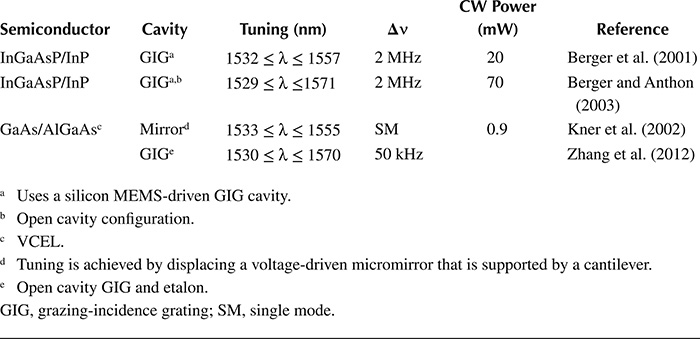
TABLE 9.24
Ultrashort Pulse External Cavity Semiconductor Lasers
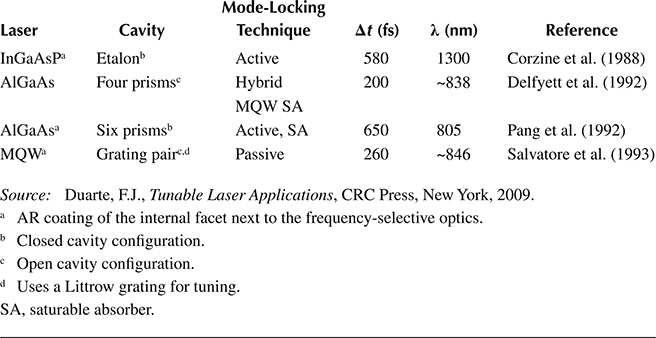
9.5.2 Tunable Quantum Dot Lasers
Quantum dot lasers engineered with external cavities have demonstrated tuning ranges within the 1000 ≤ λ ≤ 1300 nm region as indicated in Table 9.26. A tunable quantum dot laser, using InAs as gain medium and employing a diffraction grating deployed in Littrow configuration, is reported to yield a laser linewidth of Δν ≈ 200 kHz and a tuning range of 1125 ≤ λ ≤ 1288 nm. Frequency stabilization reduced the linewidth to Δν ≈ 30 kHz (Nevsky et al. 2008).
TABLE 9.25
Tunable External Cavity Quantum Cascade Lasers

TABLE 9.26
Tunable External Cavity Quantum Dot Lasers

9.6 Additional Lasers
An important source of widely tunable coherent radiation, not included in this survey, is the free-electron laser (FEL). The reason for this choice is that FELs are fairly large high-power devices that require accelerator technology. In his review of FELs, Benson (1995) reported that various devices around the world cover, with their primary emission wavelengths, the electromagnetic spectrum from 2 to 2500 μm. However, more recent advances in this field have demonstrated FEL radiation well into the extreme ultraviolet (see, e.g., Allaria et al. 2012). A book on FELs was written by Brau (1990). Sources of discretely tunable soft X-ray radiation, using Ni-like ionic transitions, in the 16.5–10.9 nm range were demonstrated by Rocca and colleagues in table-top laser configurations (Wang et al. 2005).
Additional lasers not included in this survey are chemical lasers, the far-infrared lasers, and nuclear-pumped lasers. Chemical lasers are large and powerful sources of coherent radiation suitable for military applications. The hydrogen flouride laser, which results from a reaction between H2 and F, emits in the 2.640–2.954 μm region (Miller 1988). The iodine laser, which originates from a reaction of oxygen and iodine, emits at 1.3 μm (Yoshida et al. 1988).
Far-infrared lasers are optically pumped molecular lasers that cover the spectrum deep in the infrared from 0.1 to 1 mm (see, e.g., James et al. 1988). The active media in these lasers are molecules such as HCOOH and CH3OH (Farhoomand and Pickett 1988) and the excitation is provided by tunable CO2 lasers.
Nuclear-pumped lasers use reactors as excitation sources and various gaseous mixtures as the lasing media (Schneider and Cox 1988).
Problems
9.1 A fixed wavelength metrology application in the red portion of the visible spectrum (600 ≤ 700 ≤ λ nm) requires homogeneous single-transverse-mode illumination, in a circular beam, with a Gaussian intensity profile polarized parallel to the plane of propagation, at a linewidth in the 1 ≤ Δν ≤ 3 GHz range. The required CW power is in the few milliwatts range and the space constraints are not important. Using the information given in this chapter, and other relevant chapters, select an appropriate laser that would meet the requirements using a minimum of optical components.
9.2 A fixed wavelength metrology application in the red portion of the visible spectrum (600 ≤ λ ≤ 700 nm) requires homogeneous single-transverse-mode illumination, in a circular beam polarized parallel to the plane of propagation, at a linewidth in the 1 ≤ Δν ≤ 3 MHz range. The required CW power is in the few milliwatts range and the space constraints are important. Using the information given in this chapter, and other relevant chapters, select an appropriate laser that would meet the requirements using a minimum of optical components.
9.3 A sequential selective excitation application in the orange-red portion of the visible spectrum (560 ≤ λ ≤ 610 nm) requires homogeneous single-transverse-mode illumination, in a TEM00 beam, polarized parallel to the plane of propagation, at a linewidth of Δν ≈ 350 MHz . The required average power is 100 W and the space constraints are not important. Using the information given in this chapter, and other relevant chapters, select the most direct and efficient laser that would meet the requirements using a minimum of optical complexity.
9.4 A directed energy application in the orange-red portion of the visible spectrum (560 ≤ λ ≤ 610 nm) requires homogeneous single-transverse-mode illumination, in a circular beam polarized parallel to the plane of propagation, at a linewidth in the 350 ≤ Δν ≤ 700 MHz range. The required average power is 10 kW, at a prf of 100 Hz. The space constraints are not important. Using the information given in this chapter, and other relevant chapters, select the most direct and efficient laser system that would meet the requirements using a minimum of optical complexity. An oscillator-amplifier system is allowed.
9.5 A fixed wavelength industrial application in the near-infrared portion of the spectrum (1000 ≤ λ ≤ 2000 nm) requires homogeneous single-transverse-mode illumination, in a circular beam polarized parallel to the plane of propagation, at a linewidth of Δν ≈ 1 GHz range. The required CW average power is 1 kW and the space constraints are important. Using the information given in this chapter, and other relevant chapters, select the most direct and efficient laser system that would meet the requirements using a minimum of optical complexity. An oscillator-amplifier system is allowed.
9.6 Identify the most suitable type of laser to be incorporated in a miniaturized instrumentation system for optical coherence tomography applications centered at λ≈ 1300 nm.
9.7 Consider at least two different fixed wavelength laser options for photo-lithography applications requiring radiation in the 150 ≤ λ ≤ 200 nm. The specified average power is 100 W at a prf of 1 kHz. A master oscillator power amplifier system is allowed. Compare the cost, optical complexity, and energetic differences.
